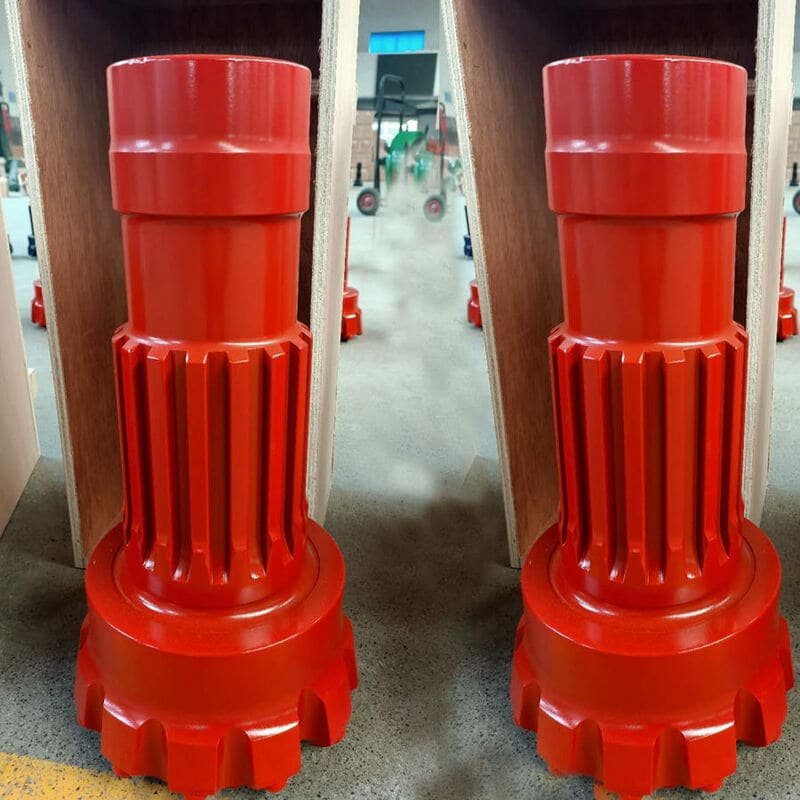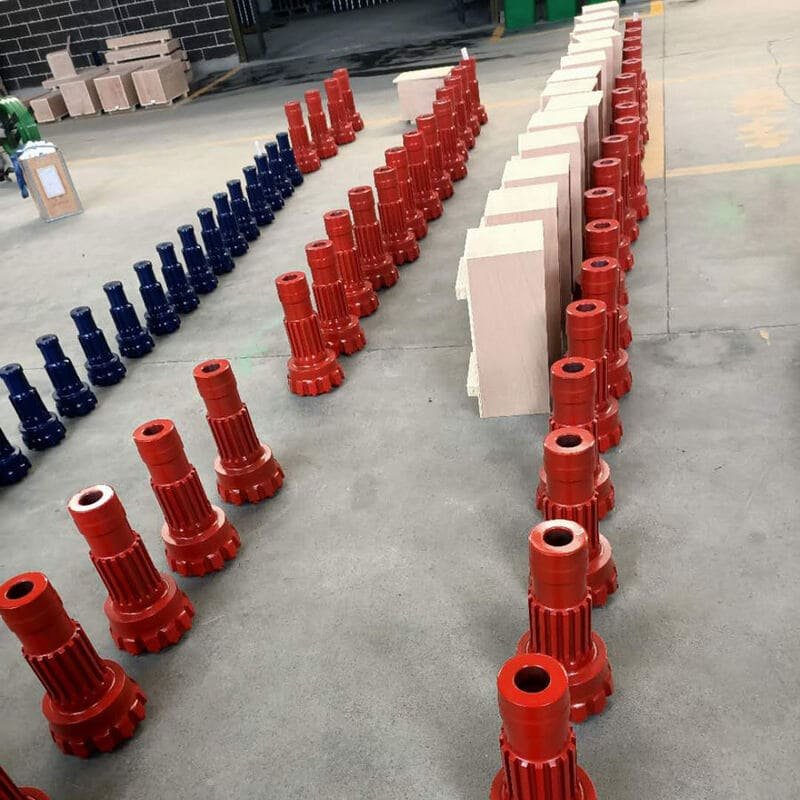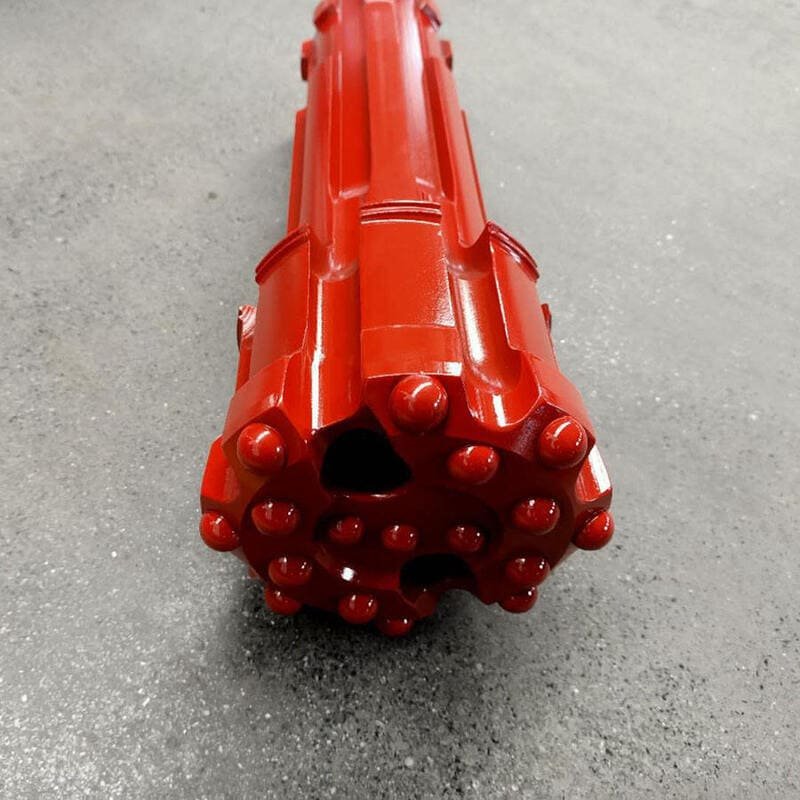Ever wondered what really happens to your drill bits on the high seas?
During sea transport, DTH drill bits often face corrosion from salty air, physical damage from rough handling, vibration issues due to constant motion, abrasion from contact with other items, and moisture damage from water ingress or condensation.
I remember the first time I shipped a batch of DTH drill bits overseas. The anticipation was as thick as fog; everything was riding on these shipments arriving in pristine condition. As I waited for updates, my mind kept circling back to the potential pitfalls.
Understanding these risks is crucial, but let's not stop there. How do we protect these bits from the sea's harshness? Let’s dive into each challenge and uncover strategies that ensure our equipment arrives ready for action, not repair.
DTH drill bits are prone to corrosion during sea transport.True
Saltwater exposure during sea transport can cause corrosion on DTH drill bits.
Vibration damage is not a concern for DTH drill bits at sea.False
Constant movement during sea transport can lead to vibration damage of DTH drill bits.
How does corrosion impact DTH drill bits during sea transport?
Remember that time you left your bike out in the rain, and it rusted overnight? Now imagine that happening to expensive drill bits on a long sea voyage.
Corrosion affects DTH drill bits during sea transport by causing rust from saltwater and humidity exposure. This degrades metal surfaces, reducing performance and lifespan. Using proper packaging and protective coatings can help prevent these issues.

The Role of Saltwater Exposure
I once took a road trip along the coast, and the salty air did a number on my car in just a few days. Now, picture DTH drill bits enduring that corrosive environment for weeks during sea transport. Saltwater is like that clingy friend who won't let go, causing metals to rust faster than you can say "oxidation." To tackle this, frequent checks and maintenance of protective coatings1 are a must.
Impact of Humidity and Condensation
Ever opened a bag of chips at the beach only to find them soggy because of the humidity? Ships face similar challenges. The humidity levels can be brutal, especially when paired with temperature swings that lead to condensation. This moisture is sneaky, seeping into packaging unless it's sealed tighter than a drum. A study on humidity effects2 shows just how important it is to use vapor-phase corrosion inhibitors and desiccants in packaging.
Packaging: The First Line of Defense
If you've ever wrapped a sandwich in cling film to keep it fresh, you get why packaging is vital for drill bits during sea transport. It's the first line of defense against corrosion. Using moisture-proof materials and airtight seals can stop corrosive elements in their tracks. Check out this table for some packaging elements:
| Packaging Element | Function |
|---|---|
| Moisture-proof Materials | Blocks humidity ingress |
| Airtight Seals | Prevents exposure to air |
| Desiccants | Absorbs excess moisture |
| Anti-corrosion Coatings | Mitigates surface oxidation |
Best Practices for Sea Transport
Just like having a travel checklist ensures nothing's left behind, implementing best practices in sea transport can significantly cut down corrosion risk. For instance, using marine-grade steel3 with advanced anti-corrosive properties is a smart move. Training logistics teams on handling and storage protocols is equally crucial.
By focusing on these strategies, I've found companies can effectively manage corrosion impacts during sea transport, ensuring DTH drill bits arrive ready to rock.
Saltwater exposure accelerates oxidation of DTH drill bits.True
Salt molecules initiate corrosion, weakening metal structures.
Humidity does not affect DTH drill bits during sea transport.False
Humidity exacerbates corrosion by causing condensation on surfaces.
What types of physical damage can occur in maritime shipping?
Ever wondered what really happens to cargo during a maritime journey? Let me take you through the hidden challenges and surprises.
Physical damage in maritime shipping can include corrosion from saltwater, impact and vibration damage from rough seas, abrasion from improper packaging, and moisture damage due to water ingress. Ensuring proper handling and packaging can mitigate these risks.

Corrosion from Saltwater Exposure
When I first started shipping goods across the ocean, I was fascinated by the sheer scale of it all—the vast ships, the endless waves, and the logistics of getting everything from Point A to Point B. However, it didn't take long for me to realize that maritime shipping is fraught with its own set of challenges, especially when it comes to protecting cargo from physical damage.
One of the most common types of damage during maritime shipping is corrosion. The high salt content in sea air can accelerate the oxidation process, especially for metal surfaces4. This can compromise the structural integrity of metal cargo like machinery.
- Mitigation: Using anti-corrosive materials and proper packaging.
Impact and Vibration Damage
Then there are those days when the sea is anything but calm. Rough seas can really take a toll on cargo—imagine your carefully packed items being jostled around like they’re in a giant washing machine. The impact can cause cracks or chips, while constant vibration might loosen components if they're not securely packed.
| Damage Type | Cause | Effect |
|---|---|---|
| Impact | Rough handling | Cracks or chips in materials |
| Vibration | Ship's motion | Loose components or fittings |
- Mitigation: Secure packaging and careful handling protocols.
Abrasion Due to Improper Packaging
One lesson I learned the hard way was about abrasion. It's not something you think about until you open a shipment and see that your items have been rubbing against each other or their container, leading to dull edges or worn surfaces.
- Solution: Immobilizing cargo within packaging to prevent movement.
Moisture Damage and Condensation
Moisture is another sneaky culprit. Even without direct water exposure, temperature changes can cause condensation inside packages. It’s amazing how a little moisture can lead to rust or mold over time if precautions aren’t taken.
- Solution: Use moisture-proof materials and desiccants.
Contaminant Ingress
Last but not least, dust and debris from the sea environment can settle on cargo—particularly troublesome for machinery. These tiny particles can cause wear or even operational failures if not dealt with properly.
- Solution: Enclosed packaging with filters to prevent contaminant entry.
By understanding these potential damages, we can better prepare for the unpredictable nature of maritime transport. It’s all about prevention and protection—two pillars that help ensure smoother and safer shipping operations.
Saltwater exposure accelerates metal corrosion.True
Salt in sea air speeds up oxidation, damaging metal surfaces.
Proper packaging prevents all maritime shipping damage.False
While it reduces risk, not all damage can be prevented with packaging.
How Does Vibration Damage Affect Drill Bit Integrity?
Imagine watching your favorite gadget slowly falling apart due to constant shaking. That's what happens to drill bits when vibrations hit them during drilling.
Vibration damage reduces drill bit integrity by inducing fatigue, resulting in cracks and fractures. This leads to diminished performance, increased wear, and possible drill bit failure.

Understanding Vibration Impact on Drill Bits
Back when I first got into drilling operations, I remember being fascinated—and a bit frustrated—by how vibrations could wreak havoc on drill bits. It's almost like they have their own secret life, suffering silently as micro-cracks form and expand over time. These tiny imperfections can eventually grow into significant fractures, especially in high-stress drilling environments5. This isn't just theory; I've seen firsthand how these micro-cracks can turn a brand-new bit into a liability if not addressed.
Types of Vibration Damage
-
Surface Wear: Think of it like wearing out your favorite sneakers. The continuous abrasive contact from vibrations is like running on rough terrain; it accelerates wear, particularly in hard rock drilling where maintaining sharpness is non-negotiable.
- Abrasive Contact6 between the drill bit and the rock face leads to accelerated wear.
-
Structural Fatigue: Have you ever bent a paperclip back and forth until it breaks? That's cyclic loading for you. Vibrations add to this stress, causing microscopic wear that can lead to significant structural damage. I've learned to respect this invisible force that can compromise even the most robust tools.
-
Thermal Stress: Picture your drill bit as a car engine revving too hard. Vibrations increase friction, heating things up, and altering the metal's properties—just like an overheated engine might lose power.
Mitigating Vibration Effects
Over the years, I've found that using vibration dampeners or specialized coatings can be lifesavers, reducing friction and extending tool life. Another key lesson? Adjusting drilling parameters like speed and pressure can significantly minimize vibration levels.
| Parameter | Impact on Vibration | Recommendation |
|---|---|---|
| Drilling Speed | Higher speeds increase vibration | Optimize speed for material type |
| Bit Pressure | Excess pressure amplifies stress | Balance pressure with bit type |
| Bit Material | Softer materials wear quickly | Use high-durability alloys |
Practical Considerations for Drilling Operations
Understanding these dynamics has been crucial in selecting the right tools and techniques for my drilling operations. It’s like choosing the perfect tool for a DIY project at home—getting it right makes all the difference. And don't forget about proper storage techniques7 during transport to prevent pre-use damage caused by vibrations.
By addressing these factors, I've been able to significantly reduce the risk of vibration-induced damage, thereby extending the lifespan of my drilling equipment—a small victory that feels pretty big in the grand scheme of things.
Vibrations cause micro-cracks in drill bits.True
Continuous vibrations induce fatigue, leading to micro-cracks in drill bits.
High drilling speed reduces vibration damage.False
Higher speeds increase vibrations, exacerbating wear and structural damage.
Why is abrasion a concern for drill bits at sea?
Imagine being on a ship, surrounded by endless waves, while worrying about the tiniest particles wearing down your drill bits.
Abrasion affects drill bits at sea primarily due to constant exposure to saltwater, debris, and friction against other objects. These factors can wear down the bits, reducing their effectiveness and lifespan.

Exposure to Saltwater and Corrosion
When I first heard about the troubles with drill bits at sea, I thought, "How bad can it be?" That was until I watched a colleague pull a corroded, almost unrecognizable bit out of the water. The constant assault by saltwater isn't just a slow burn—it's relentless. Salt particles8 can scrape against the metal like tiny, invisible sandpaper, steadily eating away at the surface.
Friction Against Other Materials
On another voyage, I remember staring at a pile of sand and rock debris collected around the equipment. It was a wake-up call seeing how these abrasive materials9 could accelerate wear on drill bits. Imagine the consistent grinding against hard surfaces day in and day out. It's like your drill bits are fighting a losing battle against an army of tiny foes.
Packaging and Transport Challenges
You'd think that simply shipping these tools would be the easy part, but oh no! A friend once shared a story of opening a crate only to find the bits had shifted during transport, rubbing against each other—each edge duller than the last. Securing these bits correctly is like wrapping a precious artifact; it's crucial to ensure they're snug as a bug with an effective packaging solution10.
Impact on Performance and Longevity
Seeing a project delayed because of worn-out drill bits is like watching money trickle down the drain. It's not just about replacement costs; it's about time lost, schedules thrown off balance. Investing in durable designs11 that resist these harsh conditions isn't just smart—it's essential for keeping operations running smoothly.
| Factor | Impact |
|---|---|
| Saltwater Exposure | Corrosion and increased abrasion |
| Material Contact | Accelerated wear from abrasive substances |
| Poor Packaging | Increased friction and damage |
Understanding these challenges helps me make better decisions about materials and protective measures. It's all about keeping those drill bits spinning efficiently while reducing those unexpected operational hiccups.
Saltwater exposure causes drill bit corrosion.True
Saltwater accelerates the corrosion process, damaging metal surfaces.
Proper packaging prevents drill bit abrasion during transport.True
Secure packaging reduces friction and contact between drill bits.
How Can I Prevent Moisture Damage on My DTH Drill Bits?
Imagine spending a fortune on DTH drill bits only to see them rust away due to moisture. It's a nightmare scenario! But with the right precautions, you can protect your investment and keep those bits in top shape.
To prevent moisture damage on DTH drill bits, store them in moisture-proof packaging, use desiccants, and regularly inspect for corrosion. Proper ventilation and temperature control are essential for maintaining their condition.

Secure Moisture-Proof Packaging
I remember a time when I underestimated the power of proper packaging. I had these brand-new drill bits, and I left them in what I thought was a secure area. A few weeks later, I discovered them with a hint of rust. Lesson learned! Now, I always ensure high-quality, moisture-proof packaging like vacuum-sealed bags or protective wraps12 for my DTH drill bits. It's a small step that makes a big difference. Always check the packaging before shipping to catch any breaches early.
Employ Desiccants
Desiccants, such as silica gel packs, have become my trusty sidekicks in the battle against moisture. I place them strategically around my drill bits13 during storage or transport. They absorb excess moisture and keep everything dry. Just remember to replace them regularly—they can only hold so much!
Regular Inspection and Maintenance
A routine inspection is like a health check-up for your drill bits. I make it a point to look for rust or discoloration, which are telltale signs of moisture exposure. By having a maintenance schedule14 for cleaning and lubricating the bits, I've been able to keep them in peak condition.
Optimize Storage Conditions
I've learned the hard way that where you store your tools matters. A controlled environment with regulated temperature and humidity levels is crucial. Using dehumidifiers and ensuring proper ventilation can prevent condensation buildup.
| Condition | Recommendation |
|---|---|
| Humidity Level | < 60% |
| Temperature Range | 15-25°C (59-77°F) |
| Ventilation | Adequate air circulation |
Consider Protective Coatings
Applying protective coatings has been another game-changer for me. Coatings like rust inhibitors15 form a barrier that protects metal surfaces from environmental moisture. It's like giving your drill bits an extra shield.
Strategic Transport Practices
When it comes to transporting these valuable tools, I've become somewhat of a strategist. Packing DTH drill bits securely to avoid movement during transit is key, especially on long journeys where temperature changes could cause condensation. Insulated containers have been particularly useful.
Leverage Technology for Monitoring
Technology has been a fantastic ally in managing storage conditions. I've started using monitoring devices that track humidity and temperature levels, giving me real-time data and alerts for any deviations. Smart sensors can be a worthwhile investment if you're serious about maintaining optimal conditions.
Desiccants prevent moisture in drill bit packaging.True
Desiccants absorb excess moisture, keeping the environment dry.
Rust inhibitors are ineffective against moisture damage.False
Rust inhibitors form a barrier protecting metal surfaces from moisture.
Conclusion
DTH drill bits face corrosion, physical damage, vibration issues, abrasion, and moisture damage during sea transport. Proper packaging and protective measures are essential to mitigate these risks.
-
Exploring protective coatings can guide you in selecting effective solutions for safeguarding drill bits during transit. ↩
-
This link explains how humidity accelerates corrosion, aiding in identifying suitable preventive methods. ↩
-
Learning about marine-grade steel helps in choosing durable materials for maritime applications. ↩
-
This link explores how saltwater accelerates metal corrosion, crucial for understanding maritime cargo risks. ↩
-
Explore how different environments affect vibration levels and subsequent damage to drill bits. ↩
-
Discover methods to minimize abrasive wear through proper equipment selection and maintenance. ↩
-
Learn about effective storage solutions to safeguard drill bits against vibration during transport. ↩
-
Learn about the chemical process of corrosion due to saltwater, crucial for protecting marine equipment. ↩
-
Explore common abrasive materials in underwater settings to better understand their impact on drill bits. ↩
-
Discover effective packaging techniques that prevent abrasion during sea transport. ↩
-
Find out which materials improve drill bit resilience against sea abrasion. ↩
-
Discover materials ideal for creating effective moisture barriers, helping ensure DTH drill bits remain rust-free during storage. ↩
-
Learn strategies for storing drill bits to maintain their condition and performance over time. ↩
-
Access a guide on setting up a maintenance routine to keep drill bits in peak condition. ↩
-
Find out about various coatings that prevent rust on metal surfaces, including drill bits. ↩








